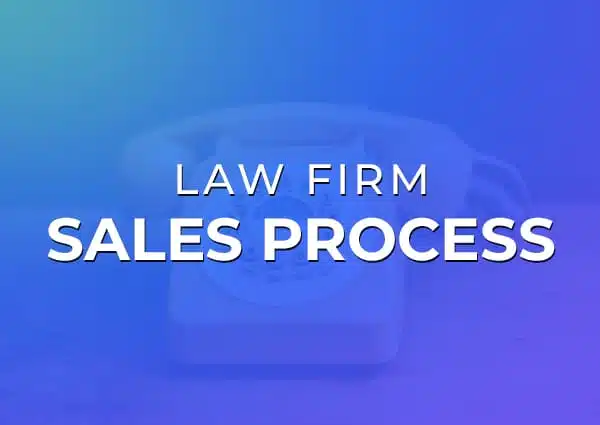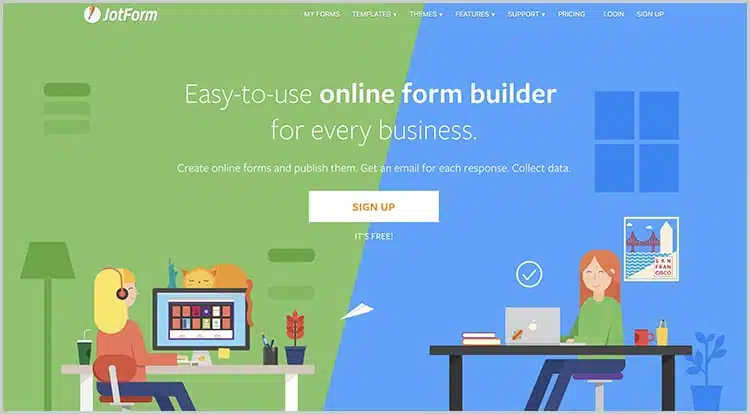Law Firm Sales Process: 10 Tips to Convert More Prospects Into Customers

And it’s a serious problem for your law firm. Not converting leads means you’re flushing your marketing budget down the drain every month.
There’s no point in leads without sales. And, there’s no point in marketing if you can’t convert.
Today I’m going to show you how to fix this problem by implementing a system to manage leads and convert more of them into paying clients.
10 tips for creating an effective sales process
Your sales process will vary to some degree according to your practice area. For instance, criminal defense leads often require urgent follow-up; you may have more time to follow up on leads as an employment law attorney.
Some leads will require more nurturing and education before they’re ready to become paying customers, and others will come to you ready to hire a lawyer.
But the following 10 sales process tips apply to virtually all practice areas:
1. Understand your customer’s journey
Map out the journey a client will take with you: from the first contact until you represent them.
It can be a long cycle so it helps to break it down into steps.
This may include:
- A contact form submission
- A telephone consultation
- A face-to-face consultation
- The submission of a contract
- The request of a deposit
- And, so on…
This will provide a clear view of your sales cycle.
This can help you:
- Plan your time and resources
- Identify the actions you need to take to progress leads through your sales cycle
- Identify bottlenecks or blockages in the process
- Identify when you need marketing campaigns to generate more leads
2. Automate wherever possible
Jeff Gitomer said, “Value the relationship more than the quota.” And it’s true that much of the sales process is about building relationships.
But we also have the technology to help us. You can save time by automating the parts of the sales process that don’t need your direct involvement. For example:
- For contact forms on your website, create an autoresponder for customers, letting them know that you’ve received their inquiry and when you will contact them. You may even outline what the next steps are, to set expectations and ensure that leads don’t feel ignored.
- A good CRM (customer relationship management software) can help you segment, rank and prioritize leads according to how far along the sales process they are. It can also track all communication with each prospect and link it to their customer profile.
- Create templates for “personalized” emails, where you essentially “fill in the gaps”. In many instances, the sales process involves saying similar things to certain groups of prospects. Automating some of the legwork by having a series of templates for each group and each stage of the sales process can save hours of time a week.
3. Encourage online scheduling of appointments
Another area that you can automate is the scheduling of appointments.
You can save precious time by encouraging prospective and existing customers to book their times with you using an online calendar that indicates times when you’re free.
If you don’t like the idea of an online calendar, ensure that leads clearly understand the process of booking with you: detail your process clearly on your website and include a call-to-action that encourages them to take the next step.
A few platforms to consider include:
4. Prepare scripts to qualify leads and establish trust
When people call your law firm or when you get back to people who’ve enquired via contact forms online, be prepared to qualify and then build trust with the customer.
Create scripts that:
- Quickly gather the information you need to qualify the customer (so that you don’t waste time)
- Talk about what makes your firm unique: successful cases, the way you help your customers, online reviews, awards, etc.
- Explain the legal process in simple terms
Scripts may feel awkward at first, but practice with them and the words will flow more naturally.
Keep the language simple and understandable and you can quickly build trust with potential customers.
5. Develop comprehensive intake forms
As part of your sales process, gathering key information from leads is very important.
Develop forms that you can go through and tick off point by point the information you need at each stage of the process.
This will help ensure that nothing important gets missed – and will also prevent having to ask for the same information twice.
Alternatively, you can develop intake documents that can be sent to the client for them to complete at their convenience.
The platform I highly recommend is Jotform. It’s inexpensive and works exceptionally well for collecting new customer info. It can also be used to process payments, collect email signups and more.
6. Be prepared for objections & questions about pricing
Objections aren’t just voiced in court. They are also voiced by customers in all professions. Expect to hear them regularly on the phone or by email.
No matter what your practice area, be prepared to answer objections from potential customers about pricing, process, and anything else that may raise questions:
- “Why do you charge by the hour – can we agree a flat rate?”
- “The firm down the street is cheaper”
- “That’s out of my budget”
- “Do we have to meet? Can I just brief you by email?”
- “I have access to some online legal forms for doing that – maybe I don’t need your services, after all”
- “How can I trust that you’ll get the result I want?”
- “I need to think about it first”
List all the objections that you hear regularly from customers and carefully script answers to them. Again, practice with these scripts until the words flow naturally.
7. Use voicemail when you’re unavailable
Lawyers are frequently out of the office.
Ensure you have a professional voicemail message for times when you’re unavailable. This will avoid both existing and potential customers feeling ignored and set their expectations accordingly.
In your message, let the caller know they should leave a number and you’ll get back to them.
Something like this:
“You’ve reached (insert name ) of (insert law firm and location – if necessary). I’m out of the office right now but thanks for calling.
Please leave your name, number and reason for calling. I’ll get back to you later in the day or, at the latest, tomorrow. If your matter is urgent, please call XXXXXXXX and someone will help you.”
The emergency number is necessary in some practice areas more than others – but always best to cover your bases.
Also create an office voicemail for your law firm, for when people call outside business hours. This can be a little more promotional than your personal voicemail.
“You’ve reached the offices of (insert law firm and location – if necessary). We specialize in (insert practice area) for (insert info about the target clients).
Our office hours are from (time) to (time), Monday to Friday. Please leave your name, number and reason for calling after the beep and we’ll get back to you as soon as possible.”
If you would like more examples, Onsip has a number of professional voicemail scripts you can customize for your firm.
8. Practice closing the sale
This is the hardest part for many lawyers.
In fact, that’s the case for many people in business. They’re fearful of hearing the word “no”.
But practice will improve performance here. That’s why we use the term sales “skills”: they can be learnt.
After you’ve qualified the lead, had the consultation and answered their objections and questions, the most important part still remains.
The prospect may not simply volunteer a “when do we start?” or “OK -how do we get going on this?” You need to formally close the sale by asking for the business.
Create a script for this – and practice it. Something like this:
“Excellent. We look forward to helping you resolve this issue. The first step in the process is to pay the retainer, which our admin staff will send within the next 30 minutes. Once payment is received, we begin…”
9. Monitor for bottlenecks and process improvement
As with all processes, they can evolve over time and be improved. Where you start may not be where you finish.
Monitor your sales process and check for areas that can be improved. Typically, it’s areas such as:
- Upgrading your CRM software
- Improving the scripts you’re using
- Improving your auto-responders & email templates
- Re-recording voicemail messages
- Tweaking your ‘closing’ message
- Changing the personnel handling inbound calls
- Improving response times for communcations
- Removing bottlenecks in your process
Often the partners or lawyers themselves are the bottlenecks in the process, causing leads to go cold because they’re not responded to in a timely manner.
This needs to be fixed to optimize your conversion rate.
10. Remarket to cold leads
You’ll always have a proportion of customers who go ‘cold’ and unresponsive. It may be that they didn’t trust you enough, went with another law firm, or their needs changed.
Depending on your practice area, it may be worth remarketing to these leads with email campaigns.
Professionally written, informative or educational emails can sometimes reignite interest in your firm and encourage people to re-engage with you.
An important post-sale tip: Ask for referrals
For some practice areas, customers are the best source of other customers.
After you convert leads into paying clients, make sure your post-sales process includes asking for referrals (more appropriate for family law than criminal defense).
This is often easier after a successful case result when the customer is feeling relief and goodwill towards you.
But unless you have a process for asking for referrals, it may get forgotten.
An email like this can help:
Hi (Name)
It was a pleasure to help you on your recent legal issue and I’m so glad we got a favourable result.
I wanted to ask a quick favour of you.
Is there anyone you know in your network who could also benefit from our legal services? If so, we’d love to help them too.
I’d really appreciate you putting us in touch witb them.
Thanks so much.
Regards
(Name)
Make sure your email carries your law firm’ branding – and keep it short and sweet.
Last tip: don’t forget to thank everyone who refers you!
Start converting more paying customers
Sales is one area that makes many lawyers cringe.
But you can run inch-perfect, best-practice digital marketing campaigns – and they will mean nothing if you can’t convert leads into paying customers.
Too many law firms approach sales on an ad hoc basis. This means that the ball can get dropped and sales opportunities can be missed.
Implementing a sales process to manage calls and web-based enquiries will make a huge difference to your firm.
Now you have some ammunition to start firing up your sales process without it taking too much of your time.
There are no longer any excuses for not converting more leads.
Dennis Dimka
As the founder and CEO of Uptime Legal Systems, I've had the privilege of guiding our company to become a leading provider of technology services for law firms.
Our growth, both organic and through strategic acquisitions, has enabled us to offer a diverse range of services, tailored to the evolving needs of the legal industry.
Being recognized as an Ernst & Young Entrepreneur of the Year Finalist and seeing Uptime Legal ranked among the Inc. 5000 list of fastest-growing private companies in America for eight consecutive years are testaments to our team's dedication.
At Uptime Legal, we strive to continuously innovate and adapt in the rapidly evolving legal tech landscape, ensuring that law firms have access to the most advanced and reliable technology solutions.

